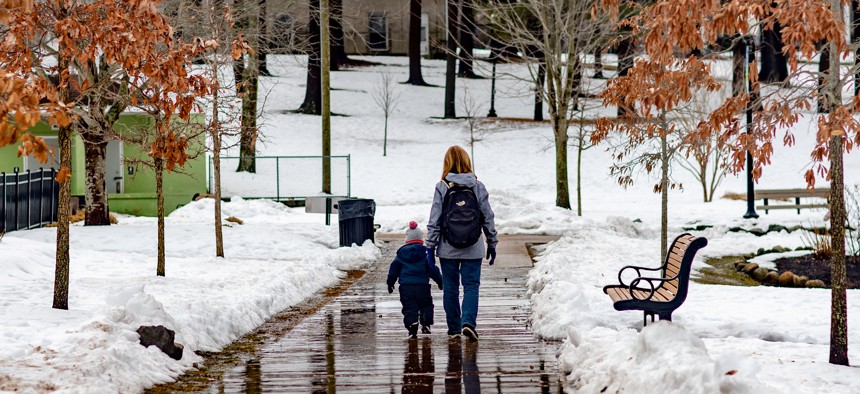5 Reasons Your Community Should Create More Green Spaces

Raychel Brightman/Newsday RM via Getty Images
COMMENTARY | A healthy community’s infrastructure isn’t only limited to roads, schools, and bridges. Investing in nature-centered spaces such as parks can contribute significantly to the community’s health and economy.
If the pandemic taught us anything, it is that public green spaces are essential. The ability to go outside and get some fresh air has never been more important. And yet, so many people lack access to parks, gardens and greenbelts.
A study from The Trust for Public Land found that those who live in underserved communities are particularly affected.
“In the 100 most populated cities,” wrote the study’s author, “neighborhoods where most residents identify as Black, Hispanic and Latinx, American Indian/Alaska Native or Asian American and Pacific Islander have access to an average of 44 percent less park acreage than predominantly white neighborhoods, and similar park space inequities exist in low-income neighborhoods across cities.”
With increased infrastructure funding, cities have a unique opportunity to invest in their public green spaces—both in claiming and reclaiming spaces and in ensuring funding to build and maintain what we have.
As cities continue to grow and urbanize, creating public green spaces that allow people to reconnect with nature is more important than ever. Indeed, with more than 80% of the U.S. population living in urban areas, communities need to offer a peaceful respite from city life. These natural oases can improve our mental and physical health, provide opportunities for physical activity and social interaction, and help clean the air and water. And increasingly, studies are showing that public green spaces have been linked to lower crime rates.
Here are the top five benefits for cities and communities when they add more green spaces.
1. Improves Physical and Mental Health
Green spaces offer a respite from our concrete and technology-filled urban environments. They provide an opportunity to reconnect with the natural world, which helps reduce stress, lower blood pressure and improve overall mood. Nature preserves promote physical activities such as hiking, biking, walking and running, which minimize the likelihood of obesity and related diseases. They serve as natural air filters, improving air quality and reducing the risk of respiratory problems. And natural environments have been proven to stimulate the mind, helping to reduce stress and fatigue and promote relaxation.
These benefits can be made accessible to everyone, regardless of age, gender or income, making it an inclusive and egalitarian way of improving people’s well-being.
2. Strengthens Social Cohesion
Parks offer a range of activities that provide an excellent opportunity for people to come together. Activities such as biking, rafting, gardening, hiking and birdwatching in nature reserves, for instance, cultivate community and social connections among residents.
I’ve seen it time and again. I lead outdoor expeditions where I live in Montana and have watched how these green spaces enable individuals of different backgrounds to interact and break down cultural barriers, promoting understanding and inclusivity.
3. Promotes Education
Creating and maintaining green spaces offers education beyond the classroom. Children and adults can use these places to explore, discover and learn about the natural world and its interconnectedness. People can also learn about ecology, geology, botany and animal behavior in nature centers, zoos and botanical gardens. Similarly, access to nature promotes critical thinking, creativity, problem-solving skills and the ability to communicate effectively, and it encourages people to become environmental stewards.
4. Conserves the Environment
Public spaces focused on nature promote biodiversity and help fight climate change.
First, trees and other vegetation are vital in absorbing carbon from the atmosphere and regulating the climate. This helps reduce the “heat island” effect in urban areas and improves air and water quality.
Second, nature regulates vital ecological processes such as pollination, seed dispersal and pest control.
Last, these designated places can serve as conservation areas that protect endangered species and preserve important habitats.
5. Supports Long-Term Economic Growth
Green spaces can drive tourism, generate income for local businesses and attract new residents and businesses to an area, all of which can lead to economic growth. For instance, these areas can serve as venues for outdoor events such as festivals, concerts and markets. Likewise, public parks promote nature-based tourism, such as ecotourism and agritourism, which can create jobs and revenue for local communities.
Patrick Sipp of Flying Pig Adventures has been leading his clients on adventures like no other, with the most recent trip including horseback riding and Yellowstone river rafting, giving them the chance to feel the spray of the river, the heat of the sun and the immensity of the world around them.
NEXT STORY: 4 reasons it's time to reassess your cloud architecture





